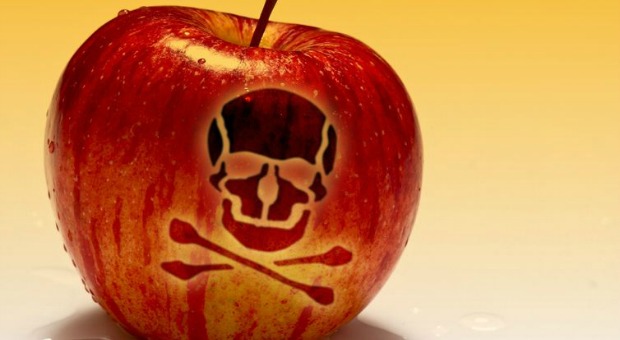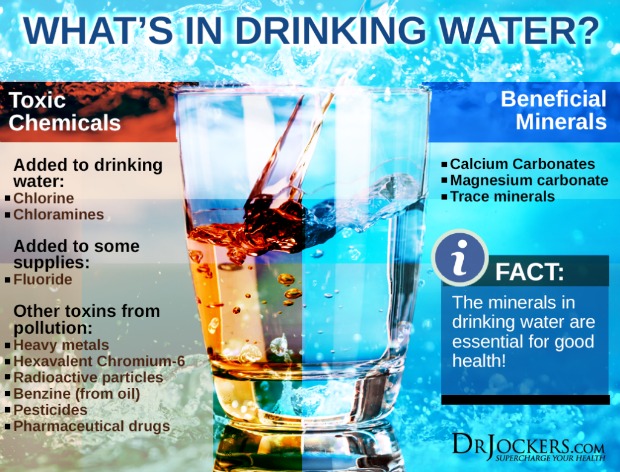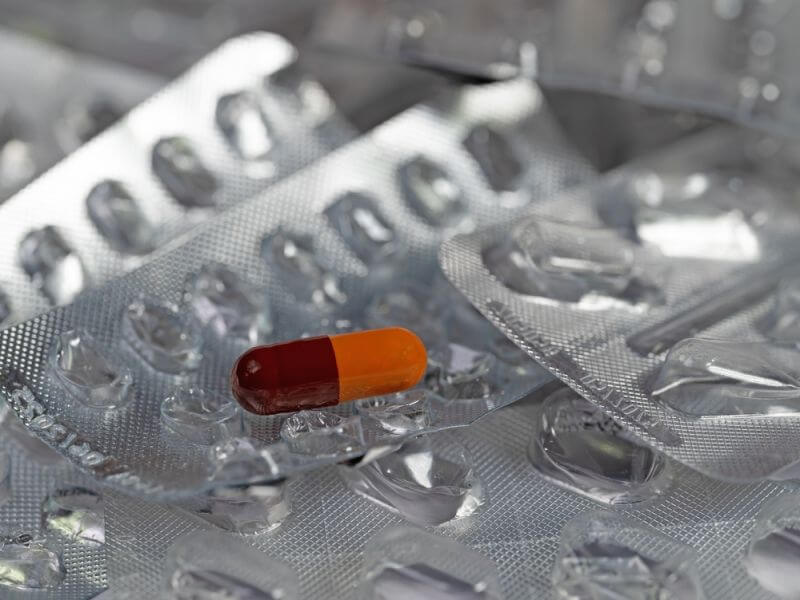We’ve gotten so far away from eating and living naturally that our bodies are responding with allergies, cancers, arthritis, and myriad other illnesses. There are, however, many changes that you can make to improve your health and your quality of life.
Toxins in Water
The first place that you should look for toxins is in your water because your drink it, you cook with it and you bathe in it. Don’t underestimate the power of toxins in water if you’re only bathing or washing your hands in it because you can absorb the toxins through your skin.
Here are the top things in your water that are killing you slowly:
Chromium 6 aka Hexavalent Chromium
This is the toxin that the movie Erin Brokovich made famous. It’s used as a coolant in factories and for in the production of chrome plating, stainless steel, tanned leather, preserved wood, pigments, and textile dyes. It’s carcinogenic and has been proven to cause everything from skin conditions to breathing problems, to cancer.
Though the chemical was “outed” in the movie, it remains prevalent in many cities across the US and there is actually a designated “safe level” of it. Personally, I’m not big on drinking anything that can kill me, no matter how small the dose.
The only way to remove chromium 6 from your water is to use an ion filtration system, but even then, you have to be extremely careful and make sure that the filter is changed regularly.
Fluoride
This is an iffy topic because fluoride is added to the water in many cities in order to fight tooth decay. However, since then, the National Academy of Science conducted a review that concluded that fluoride is an endocrine disruptor. Other studies show that it accumulates in the bones and may cause bone disorders and other health issues.
The only ways to remove fluoride from your water are reverse osmosis, deionizers, and activated alumina.
Lead
Remember all those condemned houses that had to be stripped of paint by professionals who knew how to properly dispose of lead paint? Well apparently a house with lead paint won’t pass an inspection but it’s OK to have it in drinking water.
The EPA has set the legal “safe” limit at 15ppb and all water facilities are required to test regularly for lead. The problem is that many old houses still have pipes made from lead as well as household fixtures such as brass doorknobs, so I don’t know whether this should go under water toxins or environmental toxins. It’s obviously both.
There are no safe levels of lead because it builds up in your system and can cause a whole host of conditions including abdominal pain, aggressive behavior, memory loss, high blood pressure, anemia, kidney failure and a whole host of other problems.
Regarding water, lead can be removed by standard charcoal filters. It’s up to you to remove it from your house, though if you work in an old building, there’s not much you can really do.
Chemicals and Meds
When somebody flushes their meds down the toilet, either in the form of a pill or as bodily waste, it goes into the water system.
When rainwater is washed into drains, all sorts of chemicals are washed down with them. When you clean your toilet or dump dirty wash water down the sink, you’re putting chemicals in the water supply.
Because so many city systems are antiquated, they can’t remove them. Many can be removed by reverse osmosis, though some chemicals evaporate at such a low temperature that they can’t be filtered out.
This infographic from Dr.Jokers shows exactly what is in your drinking water:
To read about other toxins in your water, and how to get rid of them, check out our article here.
Toxins in Food
All you have to do is look at the back of just about any packaged food and you’ll see a long list of ingredients that you can’t even pronounce. If you can’t say them, why on earth would you eat them?
Here’s a real kicker though – you intentionally avoid packaged foods and only make the “healthy” trek around the outside aisles of the store – produce, meat, fresh dairy. Well guess what? They’re toxic, too.
Growth Hormones
What happens when there are more people demanding chicken breasts and rib eye steaks than there are chickens and cows to provide them? Why, we simply pump them full of growth hormones to make them grow much faster than normal, right? Well, yes. That’s how it’s worked up til now.
Currently, there are six natural hormones approved by the FDA for use in food animals: estradiol, progesterone, testosterone, zeranol, melengestrolacetate trenbolone acetate. These are in addition to several synthetic hormones that are also approved. Yum, right?
Not so much. Every single one of these hormones has been linked to some sort of health problem: cancer, endocrine disruptions, mood disorders, birth defects, and thyroid disorders.
If a chemical can make a chicken grow from chick to full grown chicken in 11 weeks, what do you think that does to you? It’s OK though; the FDA gave the stamp of approval. Buy organic meat. Period. No hormones are allowed in the production of any animal that’s meant for food or to produce food.
Pesticides and Herbicides
The thing with pesticides and herbicides used in either personal or commercial gardening is that they don’t just stay on the produce. They’re absorbed into the ground and washed across the surface of the ground into bodies of water that can reach the water supply or be eaten or drunk by livestock or people.
Atrazine is extremely common and has been found in drinking water in areas that it’s used in. it disrupts hormones and may affect reproductive function.
Chlordane, Melathion and Heptachor are all associated with breast cancer.
These aren’t as big of an issue for some forms of produce as it is for others and frankly, sometimes you’re wasting your money buying organic. If you want a current list of produce that’s been sampled by the Environmental Working Group in huge quantities and shown to have either high or low traces of pesticides and herbicides, search for “The dirty dozen list” and the “clean 15 list”. Better yet, grow your own.
To learn more about toxins in foods, check out our article here.
Environmental Toxins
This list is so long that I don’t even know where to start. There are chemicals in detergents, garbage bags, cosmetics, plastic bottles, flame retardants on your clothes, furniture and furnishings; everywhere you turn, there’s some sort of toxin that you’re touching, breathing, or eating.
It’s hard to choose even a list of the top 10 environmental toxins because there are so many. Two common ones that come to mind are:
- BPA which is a chemical used to make plastics and epoxy resins that are used in everything from water bottles and food can linings to bottle tops and thermal paper receipts. It’s an endocrine disruptor that’s linked to many conditions including obesity, infertility, aggressive behavior, hormone-related cancers such as breast cancer and prostate cancer, and fertility problems.
To reduce exposure, use BPA-free water bottles (look for #7 or #3 recycling codes), eat fresh or frozen foods instead of canned foods, and don’t microwave your food in plastic.
- Phthalates are used to soften plastics and are found in many cosmetic items including shampoo, lotions, nail polish, deodorants and soap. It’s also found in many different forms of flexible plastics such as water bottles, can liners and plastic food containers. The US is in the process of phasing out phthalates but they’re still widely in use. They cause disruptive behavior in kids and thyroid dysfunction in adults.
To avoid them, look for #3 recycle code on plastics and check the ingredients in your foods and cosmetics.
Fortunately, both BPA and phthalates exit the body quickly after you stop using them. Even a few days after participants in one study quit eating packaged and canned foods, BPA levels were greatly reduced so you CAN control these particular toxins.
Everything from food and water to shampoo and water bottles and even the air we breathe is packed with toxins.
The best advice is to grow your own foods, filter your water or buy purified water, and watch the ingredients in EVERYTHING!
Even if you live in a small space or an apartment, you can still grow at least some of your own food. You’ll know exactly what’s in it, and you’ll have a sense of pride that comes from doing it.
This is definitely an abbreviated list, so if you have something to add, please do so in the comments section below.
This article has been written by Theresa Crouse for Survivopedia.












Dee | September 12, 2016
|
You missed one. Chlorine. Do a search and find out what chlorine is doing to the thyroid and why there is an increase of hypothyroid happening. This will get you started:
http://www.opus.net/water/chlorinated-water-thyroid-disorders/
Theresa Crouse | May 12, 2017
|
Good catch! With all of the crud that they’re adding to our food and water, it’s easy to overlook the obvious. But, you know, what’s a little pool chemical in your everyday water supply, right? Kidding, though the reality isn’t funny at all.